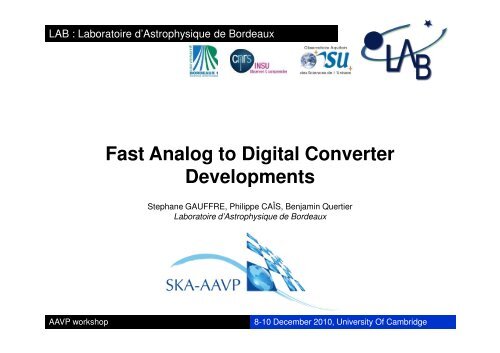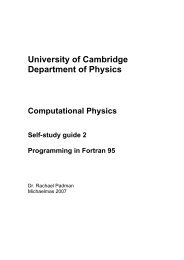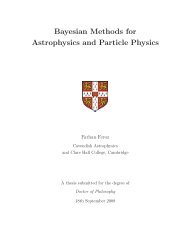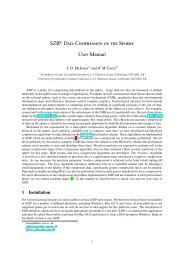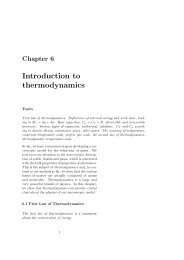Ultra fast ADC - University of Cambridge
Ultra fast ADC - University of Cambridge
Ultra fast ADC - University of Cambridge
Create successful ePaper yourself
Turn your PDF publications into a flip-book with our unique Google optimized e-Paper software.
LAB : Laboratoire d’Astrophysique de Bordeaux<br />
Fast Analog to Digital Converter<br />
Developments<br />
Stephane GAUFFRE, Philippe CAÏS, Benjamin Quertier<br />
Laboratoire d’Astrophysique de Bordeaux<br />
AAVP workshop 8-10 December 2010, <strong>University</strong> Of <strong>Cambridge</strong>
LAB : Laboratoire d’Astrophysique de Bordeaux<br />
Outline<br />
<strong>ADC</strong> designed by LAB<br />
Herschel<br />
ALMA<br />
<strong>Ultra</strong> <strong>fast</strong> <strong>ADC</strong><br />
Current Design<br />
Future Design<br />
AAVP context<br />
Low Power <strong>ADC</strong><br />
AAVP workshop 8-10 December 2010, <strong>University</strong> Of <strong>Cambridge</strong>
LAB : Laboratoire d’Astrophysique de Bordeaux<br />
• <strong>ADC</strong> designed by LAB:<br />
– Flash architecture used for our applications.<br />
<strong>Ultra</strong> <strong>fast</strong> <strong>ADC</strong> (>1GS/s)<br />
Large analog bandwith (≥1 octave)<br />
Low resolution (≤6-bit)<br />
AAVP workshop 8-10 December 2010, <strong>University</strong> Of <strong>Cambridge</strong>
LAB : Laboratoire d’Astrophysique de Bordeaux<br />
• <strong>ADC</strong> designed by LAB: Herschel Space Observatory (HiFi)<br />
– Cooperation between three groups from Bordeaux (LAB, IMS) and Toulouse<br />
(CESR), 2002<br />
– 2-bit <strong>ADC</strong> at 500MS/s designed in 0.8µm BiCMOS Technology from AMS for ESA<br />
space program (HSO).<br />
– Flash architecture<br />
– Power consumption: ≈280mW<br />
AAVP workshop 8-10 December 2010, <strong>University</strong> Of <strong>Cambridge</strong>
LAB : Laboratoire d’Astrophysique de Bordeaux<br />
• <strong>ADC</strong> designed by LAB: ALMA<br />
2-4 GHz<br />
4 GHz<br />
0 dBm<br />
– Cooperation between two groups from Bordeaux (LAB, IMS), 2005<br />
– 3-bit <strong>ADC</strong> at 4GS/s designed in 0.25µm SiGe BiCMOS Technology from STm<br />
– Flash architecture<br />
– Power consumption: ≈1.45W<br />
VH<br />
Amplifier<br />
VL<br />
OTA<br />
Bandgap<br />
Adaptater<br />
amplifier<br />
Clock<br />
buffer<br />
+<br />
-<br />
+<br />
-<br />
+<br />
-<br />
+<br />
-<br />
+<br />
-<br />
+<br />
-<br />
+<br />
-<br />
D<br />
D<br />
D<br />
D<br />
D D<br />
D<br />
D<br />
D<br />
D<br />
D<br />
D<br />
D<br />
D<br />
FDL<br />
encoder<br />
D-Latch<br />
D-Latch<br />
D-Latch<br />
Output<br />
buffer<br />
Output<br />
buffer<br />
Output<br />
buffer<br />
AAVP workshop 8-10 December 2010, <strong>University</strong> Of <strong>Cambridge</strong><br />
D0<br />
D1<br />
D2
LAB : Laboratoire d’Astrophysique de Bordeaux<br />
• <strong>ADC</strong> designed by LAB: ALMA<br />
– The 4GS/s 3-bit <strong>ADC</strong> runs with 3 1:16 DMUX circuits designed by LAB with STm<br />
0.25µm SiGe BiCMOS technology.<br />
– Total power consumption: 1.45+0.7×3=3.55W (power supply at 2.5V)<br />
– Wafers specialy manufactured for the ALMA project (>800 sampler chips and<br />
>2000 DMUX chips)<br />
– Around 300 Digitizer modules assembled, tested and validated to equip 66<br />
antennas<br />
AAVP workshop 8-10 December 2010, <strong>University</strong> Of <strong>Cambridge</strong>
LAB : Laboratoire d’Astrophysique de Bordeaux<br />
• <strong>Ultra</strong> <strong>fast</strong> <strong>ADC</strong>:<br />
– To design an ultra <strong>fast</strong> <strong>ADC</strong>, we must find a finer technology.<br />
– We can have access to the 65nm CMOS technology from STm via the broker in<br />
IC, the CMP.<br />
⇒ multi-projects wafer<br />
– Ft=210GHz<br />
⇒ high speed component<br />
– CMOS tech. & Power supply=1.2V<br />
⇒ low power consumption<br />
AAVP workshop 8-10 December 2010, <strong>University</strong> Of <strong>Cambridge</strong>
LAB : Laboratoire d’Astrophysique de Bordeaux<br />
• <strong>Ultra</strong> <strong>fast</strong> <strong>ADC</strong>: Track And Hold Circuit (65nm CMOS techn.)<br />
– Cooperation between three groups from Bordeaux (LAB, IMS, CENBG), 2010<br />
– 8GS/s Track and Hold circuit with an analog bandwith <strong>of</strong> 7.5GHz (0.5-8GHz)<br />
– Designed with 65nm CMOS technology from STm<br />
– ENOB≈4.5bit, Input Refllexion
LAB : Laboratoire d’Astrophysique de Bordeaux<br />
• <strong>Ultra</strong> <strong>fast</strong> <strong>ADC</strong>: 8GS/s 3-bit <strong>ADC</strong> (65nm CMOS techn.)<br />
– 8GS/s 3-bit flash <strong>ADC</strong> with an analog bandwith <strong>of</strong> 8GHz and internal 1:4 DMUX.<br />
– Designed with 65nm CMOS technology from STm<br />
– Chip-On-Board<br />
– Power consumption: ≈500mW (simulated result)<br />
⇒ The layout drawing files were sent to STm foundry last week.<br />
AAVP workshop 8-10 December 2010, <strong>University</strong> Of <strong>Cambridge</strong>
LAB : Laboratoire d’Astrophysique de Bordeaux<br />
• <strong>Ultra</strong> <strong>fast</strong> <strong>ADC</strong>: 8GS/s 3-bit <strong>ADC</strong> (65nm CMOS techn.)<br />
– The outputs speed rate is too high (2GS/s) to capture the synchronous digital data<br />
with standard FPGA<br />
⇒ External DMUX circuits are needed to use this ultra <strong>fast</strong> <strong>ADC</strong><br />
⇒ Total power consumption increases (>3W)<br />
Internal<br />
DMUX DMUX<br />
AAVP workshop 8-10 December 2010, <strong>University</strong> Of <strong>Cambridge</strong>
LAB : Laboratoire d’Astrophysique de Bordeaux<br />
• <strong>Ultra</strong> <strong>fast</strong> <strong>ADC</strong>: Future design in 65nm CMOS Technology<br />
– In 2011, a new 8GS/s Track and Hold circuit will be designed to improve the<br />
linearity in order to obtain an ENOB superior to 6 bits.<br />
– This new Track and Hold circuit will be:<br />
designed with 65nm CMOS technology from STm.<br />
used in a new ultra <strong>fast</strong> <strong>ADC</strong>.<br />
• A 8GS/s 6-bit flash <strong>ADC</strong> (2012): prototype version in which will be<br />
implemented<br />
Calibration circuit to compensate the comparator <strong>of</strong>fsets deviation<br />
due to the small size <strong>of</strong> the NMOS transistor<br />
Add scrambler circuit to mix a pseudo random pattern to digital<br />
data in order to capture <strong>ADC</strong> outputs using high speed receivers <strong>of</strong><br />
standard FPGA (6.5GS/s)<br />
⇒ Internal 1:4 DMUX will be replaced by 1:2 DMUX<br />
⇒ No need <strong>of</strong> external DMUX<br />
Chip-On-Board<br />
• A 8GS/s 6-bit flash <strong>ADC</strong> (2013): Final version<br />
Packaged version (fcBGA)<br />
AAVP workshop 8-10 December 2010, <strong>University</strong> Of <strong>Cambridge</strong>
LAB : Laboratoire d’Astrophysique de Bordeaux<br />
• <strong>Ultra</strong> <strong>fast</strong> <strong>ADC</strong>: 8GS/s 6-bit <strong>ADC</strong> (65nm CMOS techn.)<br />
– Rough estimation <strong>of</strong> power consumption if 6-bit designed with the same flash<br />
architecture as 3-bit <strong>ADC</strong> (with scrambler circuit and internal1:2 DMUX circuits)<br />
Power in mW<br />
1750<br />
1500<br />
1250<br />
1000<br />
750<br />
500<br />
250<br />
0<br />
2 3 4 5 6 7<br />
Resolution (Number <strong>of</strong> bit)<br />
AAVP workshop 8-10 December 2010, <strong>University</strong> Of <strong>Cambridge</strong>
LAB : Laboratoire d’Astrophysique de Bordeaux<br />
• AAVP Context<br />
– <strong>ADC</strong> technical parameter requirements:<br />
Resolution : 4-6bit<br />
Sample rate: ≥3GS/s<br />
Bandwith:<br />
• AA-lo: 70MHz to 450MHz<br />
• AA-mid: 400MHz to 1.4GHz<br />
Power:
LAB : Laboratoire d’Astrophysique de Bordeaux<br />
• AAVP Context: what could be done<br />
– Design an <strong>ADC</strong> for AAVP program<br />
Which <strong>ADC</strong> architecture is suitable for AAVP program?<br />
• Sampling rate: The flash achitecture is the <strong>fast</strong>est<br />
• Low power ⇒ state-<strong>of</strong>-the-art in 65nm CMOS technology<br />
« A 6-bit 5GS/s Nyquist A/D converter in 65nm CMOS<br />
technology », Choi, June 2008: flash architecture, analog BW:<br />
2.5GHz, power consumption: 320mW<br />
• The design <strong>of</strong> a low power 3GS/s 6-bit flash <strong>ADC</strong> is possible with the<br />
65nm CMOS technology.<br />
AAVP workshop 8-10 December 2010, <strong>University</strong> Of <strong>Cambridge</strong>
LAB : Laboratoire d’Astrophysique de Bordeaux<br />
• AAVP Context: what could be done<br />
– Design an <strong>ADC</strong> for AAVP program<br />
Which <strong>ADC</strong> architecture is suitable for AAVP program?<br />
• Folding architecture?<br />
AAVP workshop 8-10 December 2010, <strong>University</strong> Of <strong>Cambridge</strong>
LAB : Laboratoire d’Astrophysique de Bordeaux<br />
• AAVP Context: what could be done<br />
– Design an <strong>ADC</strong> for AAVP program<br />
Folding Architecture Number <strong>of</strong> comparator:<br />
Full Flash <strong>ADC</strong>: 2N-1 Folding <strong>ADC</strong>: ≈(2N-1)/2 3-bit flash <strong>ADC</strong><br />
⇒ 7 comparators<br />
3-bit folding <strong>ADC</strong><br />
⇒ 3 comparators<br />
The folding architecture<br />
seems to be the most relevant<br />
for AAVP<br />
AAVP workshop 8-10 December 2010, <strong>University</strong> Of <strong>Cambridge</strong>
LAB : Laboratoire d’Astrophysique de Bordeaux<br />
• AAVP Context: what could be done<br />
– Design an <strong>ADC</strong> for AAVP program<br />
Which <strong>ADC</strong> architecture is suitable for AAVP program?<br />
• If the flash architecture is replaced by folding architecture, the power<br />
consumption <strong>of</strong> <strong>ADC</strong> can be reduced by about 30%<br />
• Folding ⇒ state-<strong>of</strong>-the-art in 45nm CMOS technology<br />
« Design <strong>of</strong> a 12.5GS/s 5-bit folding A/D converter », Surano, 2009:<br />
analog BW: 6GHz, power consumption: 53mW (simulated result)<br />
The design <strong>of</strong> a low power 3GS/s 6-bit <strong>ADC</strong> using a flash folding architecture<br />
is possible with 65nm CMOS technology<br />
LAB has access to the 65nm CMOS technology from STm<br />
The design <strong>of</strong> an <strong>ADC</strong> for AAVP could be included in our roadmap<br />
Funding:<br />
For design: 200k€ is needed to design such <strong>ADC</strong>: 3 FTE + 2 foundry<br />
runs (prototype and final version)<br />
For production: wafer cost: >250k€ (to be confirmed), depends on the<br />
number <strong>of</strong> <strong>ADC</strong> needed<br />
AAVP workshop 8-10 December 2010, <strong>University</strong> Of <strong>Cambridge</strong>
LAB : Laboratoire d’Astrophysique de Bordeaux<br />
Thank you for<br />
your<br />
ATTENTION<br />
AAVP workshop 8-10 December 2010, <strong>University</strong> Of <strong>Cambridge</strong>


